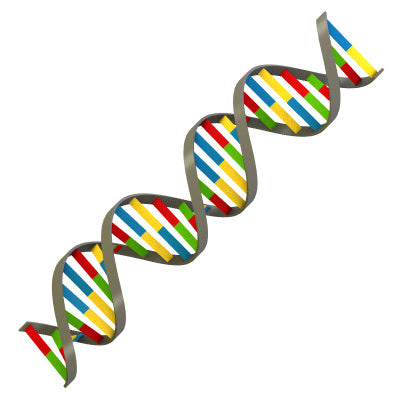What is a strand of DNA?

An inside look into the molecular structure of life.
On our previous article How DNA Works: the library of life, we went into detail regarding what DNA actually is, its composition and how it determines the fate of every cellular process within your body. Specifically, we talked about the central dogma of biology and how this theory suggests that DNA is converted into RNA through the process of transcription and further turned into proteins through the process of translation.
We also discussed that the integrity of every step in this process, from DNA all the way to proteins, is crucial for cellular health. Finally, we mentioned how certain genes (portions of DNA that code one specific protein) within your DNA can predispose individuals to certain risk factors, or in turn, protect them from such, depending on the functional protein produced.
Nonetheless, we know that these predispositions are not set in stone and that DNA frequently interacts with the environment to suppress or promote the expression of certain gene traits. The branch of genetics that studies this close interrelationship between DNA and the environment is known as epigenetics.
Despite our in depth review, there is one thing that we did not go so much into detail about: what is a strand of DNA?
The following section will give you a better idea of what biologists refer to when they talk about a “strand of DNA” and how this structure is at the core of the function of DNA.
Why a strand?
As mentioned in our previous article, DNA is composed of smaller building block units known as nucleotides. Nucleotides bind to each other by their phosphate groups (-PO) forming a chemical bond known as a phosphodiester bond. This structure is known as the sugar phosphate backbone and yields only one strand like so:

In the picture above, the hexagonal figure represents the sugar portion of the nucleotide (in the case of DNA: deoxyribose) while the “P” represents the phosphate group, whose structure is also shown below:

The lines connecting one “P” to another represent the phosphodiester bonds. Don’t get too caught up on the sciency stuff, though. Just remember that a strand of DNA is made up of billions of these nucleotides bound together by very strong chemical bonds.
The actual DNA structure is double stranded and winds around which results in its helical shape almost resembling a spiral staircase:

The picture above is far more familiar to the common person than the ones we have previously introduced in this article. So where does this second strand come from and how does it bind to the first strand giving DNA its famous helical shape?
Well, one thing we have not discussed is that nucleotides also contain a third chemical group aside from the sugar (deoxyribose) group and phosphate group that is a crucial part of the DNA structure. This third group is known as a nitrogenous base group. In the picture above, the nitrogenous base group is depicted by the colored lines on the inside of the helix.
For DNA, the four nitrogenous bases are: adenine/A, thymine/T, cytosine/C and guanine/G. A and T always pair up together using hydrogen double bonds (a type of chemical bond), while C and G always pair up together using hydrogen triple bonds. In fact, C and G pairs are thought to be stronger than A and T pairs. This has been previously demonstrated through experiments looking at the point at which the C and G bond melts (i.e. the melting point).
The important thing to remember is that the nitrogenous bases on one strand bind to the nitrogenous bases on the other strand, giving rise to the double stranded DNA structure. Below is a picture of the double strand all the way to the molecular level:

Although the building blocks of a DNA strand are microscopic and cannot be seen by the naked eye, the raw size of one single strand of DNA extended vertically across its entire length can run for miles at a time.
So how does it fit into a microscopic cell?
Once DNA has been successfully replicated during cell division, it is further packaged together through a process known as supercoiling (or in simpler words, coiling on top of coiling). During supercoiling, a non-condensed (extended into its raw form) DNA is further condensed using a special protein known as a histone. A certain length of DNA wraps around every three or so histones over and over, which allows the entire length of the DNA strand to be fit into the nucleus of the cell like so:

A portion of DNA wrapped around a large group of histones is referred to as a nucleosome. Further condensation occurs leading to a chromosome, or the most condensed form of DNA that fits into the nucleus. It is also good to note that this packaging does not occur simply to fit DNA into a cell, but has other purposes such as protecting DNA from unwanted chemical or physical forces. That right there, is the beauty of DNA and its complexity.

